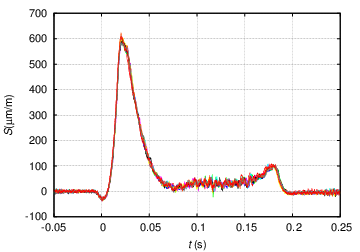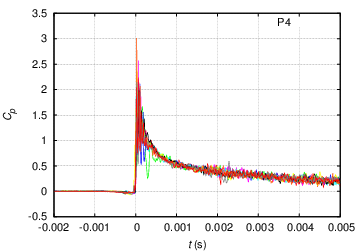The use of the elastic ropes to accelerate the trolley does not allow precise control of the test speed. Generally, the test speed is adjusted within +/- 0.5 m/s by moving back and forth the point at which the catapult is released. In order to assess the dispersion of the measurements and the repeatability capabilities of the facility, ten repeats of the same test were performed for tests on the flat plate at 10 and 4 degrees pitch angle. The aluminum plate, 15 mm AL2024 T3, was thick enough to ensure that the plate deformation remained well within the purely elastic range. The analysis was carried out for U=40 m/s, V=1.5 m/s. An excellent overlapping of the data was found in terms of pressures, strains, and loads, for the 10 degrees condition. For the tests at 4 degrees pitch angle, the entrainment of air bubbles beneath the plate causes a scattering of the pressure records, particularly for probes located at the rear of the plate which are the first to get in contact with the water. In spite of the scatter of the pressure measurements, the data in terms of strains and loads display very high repeatability. Some of the results are given here below whereas further details can be found in Iafrati et al. (2015).

Pressure, 10 degrees pitch 
Strains, 10 degrees pitch 
Pressure, 4 degrees pitch 
Strains, 4 degrees pitch 
Underwater image, 4 degrees: the air bubbles entrained beneath the plates are responsible for the scatter in the pressure measurements. 
Force acting normal to the plate: 10 degrees 
Force acting normal to the plate: 4 degrees
A. Iafrati, S. Grizzi, L. Benitez-Montanes, M. Siemann, High-speed ditching of a flat plate: Experimental data and uncertainty assessment, Journal of Fluids and Structures, Vol. 55, pp. 501-525, 2015.

